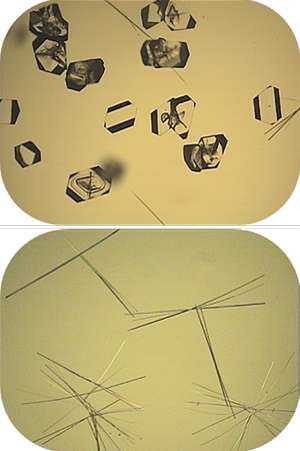Surface chemistry controls the selective nucleation of crystal polymorphs of a pharmaceutical drug

Reliable batch-to-batch formation is crucial for crystalline, active pharmaceutical ingredients as two different polymorphs of the same drug may function very differently in the body. Sendhil Poornachary from the A*STAR Institute of Chemical and Engineering Sciences and colleagues now report that the surface chemistry of modified glass substrates can influence the nucleation and formation of specific polymorphs of the drug, carbamazepine, within a certain concentration range of supersaturated solutions.
The isolation of a specific polymorph is usually achieved by controlling homogeneous crystal nucleation. However, heterogeneous nucleation—which relies on the presence of a nucleating surface—is more 'thermodynamically favorable', meaning less energy is required. The most common heterogeneous method is to add seed crystals to a solution, but problems such as inconsistencies in seed crystal properties and cross-nucleation between crystal polymorphs may result in unwanted polymorphs.
Poornachary and team show that modified glass surfaces can selectively nucleate two different polymorphic forms of carbamazepine, an anticonvulsant and mood-stabilizing drug. "This concept of template-induced crystallization shows promise for improving batch-to-batch reproducibility with respect to the crystal form obtained," says Poornachary.
The researchers produced cyano-, mercapto- and fluoro-functionalized glass vials by altering the interior surface using a silanization method, and then observed crystallization of the drug from supersaturated ethanol solutions. The two polymorphs were easily distinguished; either needle-shaped crystals corresponding to the metastable form II or tetrahedral-shaped crystals of the more energetically stable form III (see image).
The researchers found that at an initial drug concentration of 60 milligrams per milliliter, the metastable form II crystals were preferentially formed on the cyano-surface with no evidence of the crystals transforming to the more stable polymorph even after 24 hours. The mercapto- and fluoro-surfaces, however, preferentially nucleated form III with a small amount of metastable form II. In control vials, both polymorphs crystallized in tandem and transformed to the stable form within 24 hours. The time taken for the first crystals to appear was similar for all three modified surfaces, and significantly faster than in the control vials.
"We plan to improve our fundamental understanding of this template-induced crystallization process through molecular modeling and simulation," says Poornachary.
The researchers envisage that better knowledge of the molecular packing arrangements in the crystal polymorphs—along with an enhanced understanding of crystal nucleation—may enable the design of template substrates with specific chemistries, eventually improving polymorphic selectivity for a variety of active pharmaceutical ingredients.
"We are also exploring scale-up of the template-induced crystallization approach using functionalized seed crystals and template particles," added Poornachary.
More information: Parambil, J. V., Poornachary, S. K., Tan, R. B. H. & Heng, J. Y. Y. Template-induced polymorphic selectivity: The effects of surface chemistry and solute concentration on carbamazepine crystallisation. CrystEngComm 16, 4927–4930 (2014). dx.doi.org/10.1039/c3ce42622j



















